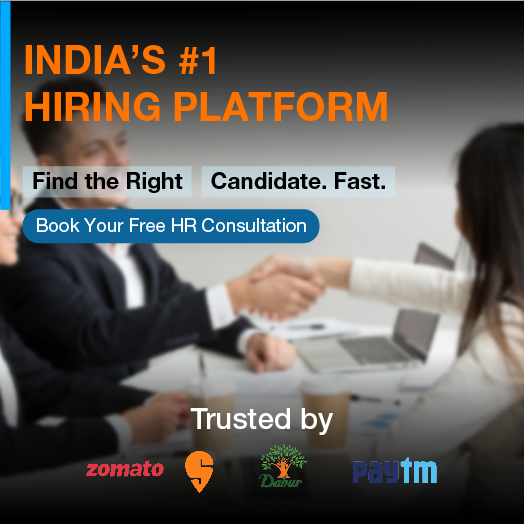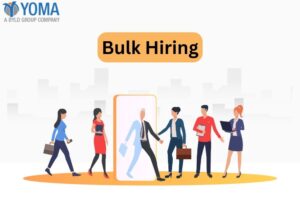
The Evolution and Importance of Staffing in India
- Our Subject Matter Experts
- December 17, 2024

Article Content:
• The Role of Recruitment Agencies
• Trends and Innovations in Staffing
• Challenges and Solutions in Staffing
• The Impact of Economic Changes on Staffing
• The Role of Technology in Staffing
• Importance of Skill Development in Staffing
Introduction
Staffing in India has become a vital aspect of human resource management as the country undergoes rapid economic and technological changes. The concept of staffing in India involves recruiting, training, and managing employees to ensure that organizations have the right talent in place. With a diverse and growing population, effective staffing practices are essential for businesses to find and retain skilled employees.
In the Indian job market, the role of staffing has expanded to include various types of staffing services, such as general staffing, IT staffing companies in India, and industrial staffing services. These services cater to different sectors and help organizations meet their specific needs. For instance, IT staffing companies in India focus on finding and placing technology professionals, while industrial staffing services are geared towards manufacturing and production roles.
Moreover, the importance of staffing is reflected in the rise of staff augmentation services, which provide temporary or contract-based solutions to address short-term needs. Temporary staffing services, contract staffing in India, and professional staffing companies play a crucial role in this landscape, offering flexibility and expertise. As the job market continues to evolve, understanding the nuances of staffing in India becomes increasingly important for both employers and job seekers.
The Role of Recruitment Agencies
- Talent Sourcing: Recruitment agencies play a crucial role in talent sourcing, helping organizations find suitable candidates for various roles. They leverage multiple channels, including job boards, social media, and professional networks, to identify top talent. For example, IT staffing companies in India specialize in sourcing technology professionals with the right skills for IT roles.
- Screening and Selection: One of the core functions of recruitment agencies is to screen and select candidates. They conduct initial assessments, interviews, and background checks to ensure that only the most qualified candidates are presented to employers. This process is vital for maintaining high standards in staffing and ensuring that candidates meet the job requirements.
- Market Insights: Recruitment agencies provide valuable market insights, such as salary benchmarks and industry trends. This information helps organizations make informed decisions about their staffing strategies and compensation packages. For instance, professional staffing companies often offer insights into the best practices for hiring and retaining talent in specific industries
Transform Your Hiring with Expert Staffing Solutions
Revamp your hiring strategy with our expert staffing services
Trends and Innovations in Staffing
- Rise of Gig Economy: The gig economy is transforming traditional staffing models, with more professionals opting for freelance or contract work. This shift has led to the growth of staff augmentation services, which offer flexible staffing solutions to manage short-term or project-based needs. Organizations are increasingly adopting these models to stay agile and responsive to market demands.
- Use of AI and Automation: Artificial intelligence (AI) and automation are revolutionizing staffing practices. AI-powered tools are used for resume screening, candidate matching, and even conducting initial interviews. These technologies enhance efficiency and reduce biases in the recruitment process, making it easier for staffing agencies to find the right candidates.
- 3.Emphasis on Diversity and Inclusion: There is a growing focus on diversity and inclusion in staffing. Organizations are implementing strategies to ensure a diverse workforce, recognizing that varied perspectives drive innovation and performance. Recruitment agencies are increasingly incorporating diversity and inclusion metrics into their staffing processes to support these goals.
Challenges and Solutions in Staffing
- Talent Shortages: Talent shortages are a significant challenge in staffing, particularly in specialized fields such as IT and healthcare. To address this issue, organizations are investing in training programs and partnering with educational institutions to build a pipeline of skilled talent. Additionally, staffing agencies are developing strategies to attract and retain candidates with niche skills.
- High Turnover Rates: High employee turnover can disrupt operations and increase recruitment costs. Solutions to this challenge include improving employee engagement through recognition programs, offering competitive compensation, and creating a positive work environment. Recruitment agencies also play a role in helping organizations develop strategies to retain top talent.
- Compliance Issues: Navigating labor laws and compliance requirements can be complex, especially for organizations operating in multiple regions. To manage this challenge, companies are adopting comprehensive compliance management systems and consulting with legal experts. Recruitment agencies also assist in ensuring that staffing practices align with legal and regulatory standards.
- Cultural Fit: Ensuring that new hires align with the company culture is crucial for long-term success. Recruitment agencies are increasingly focusing on cultural fit assessments to match candidates with the organizational ethos. This approach helps in creating a harmonious work environment and improving employee retention.
- Remote Work Challenges: The rise of remote work introduces new staffing challenges, such as managing remote teams and ensuring productivity. Organizations are investing in technology and developing remote work policies to address these issues effectively. Staffing agencies also support companies by providing solutions for remote workforce management.
Future of Staffing in India
The future of staffing in India is poised for significant transformation. Technological advancements will continue to drive changes in recruitment practices, with AI and data analytics playing a central role. The demand for flexible work arrangements, such as remote work and freelance opportunities, will shape the staffing landscape.
Moreover, the emphasis on continuous skill development and learning will become increasingly important as industries evolve and new technologies emerge. Organizations will need to adapt to these changes by adopting innovative staffing solutions and investing in their workforce. The evolution of staffing in India will be marked by greater flexibility, efficiency, and alignment with global trends, ensuring that both employers and employees can navigate the future of work successfully.
The Impact of Economic Changes on Staffing
- Economic Reforms: Economic reforms in India, such as deregulation and liberalization, have significantly impacted staffing practices. These reforms have led to increased foreign investment and a more competitive job market. Staffing agencies have had to adapt to these changes by developing new strategies and services to meet the evolving needs of businesses.
- Market Fluctuations: Economic fluctuations, including periods of growth and recession, affect staffing demand. During economic downturns, companies may reduce hiring or implement cost-cutting measures, leading to decreased demand for staffing services. Conversely, during periods of economic expansion, the demand for skilled professionals often increases, driving the need for more robust staffing solutions.
- Sector-Specific Growth: Different sectors experience varying levels of growth, which impacts staffing needs. For example, the technology sector has seen rapid expansion, leading to increased demand for IT staffing companies in India. Similarly, industrial staffing services have been crucial for sectors like manufacturing and construction. Staffing agencies must stay attuned to sector-specific trends to provide relevant services.
- Government Policies: Changes in government policies, such as labor laws and taxation, can influence staffing practices. Organizations need to stay informed about policy changes and adapt their staffing strategies accordingly. Recruitment agencies also play a role in helping businesses navigate these changes and ensure compliance.
- Global Economic Trends: Global economic trends, such as trade agreements and geopolitical developments, impact staffing in India. Companies with international operations need to consider global labor market conditions when planning their staffing strategies. Recruitment agencies with a global perspective can assist organizations in managing these complexities.
The Role of Technology in Staffing
- AI and Machine Learning: AI and machine learning technologies are transforming staffing by automating various aspects of the recruitment process. AI-powered resume screening tools can quickly analyze large volumes of applications and identify the most suitable candidates. Machine learning algorithms can also enhance candidate matching by analyzing data from previous hires and predicting future success.
- Recruitment Software: Advanced recruitment software has become essential for managing the staffing process. These platforms offer features for job posting, application tracking, and analytics. By streamlining these tasks, recruitment software helps staffing agencies and organizations improve efficiency and make data-driven decisions.
- Online Job Platforms: Online job platforms and social media networks are critical for modern staffing practices. Platforms like LinkedIn and Indeed allow employers to reach a wider audience and connect with potential candidates more effectively. These tools also enable job seekers to explore opportunities and apply for positions with greater ease.
Importance of Skill Development in Staffing
- Addressing Skill Gaps: Skill development programs are essential for addressing skill gaps in the workforce. By investing in training and development, organizations can ensure that employees have the necessary skills to meet current and future job requirements. This approach is particularly important for industries experiencing rapid technological advancements.
- Enhancing Employability: Skill development initiatives enhance employability by equipping individuals with relevant skills and knowledge. This improves their chances of securing meaningful employment and advancing their careers. Recruitment agencies often collaborate with educational institutions and training providers to support skill development efforts.
- Supporting Career Growth: Continuous learning and skill development support career growth and progression. Employees who engage in ongoing development are more likely to achieve career advancement and job satisfaction. Organizations that prioritize skill development can foster a culture of continuous improvement and innovation.
- Aligning with Industry Trends: Staying updated with industry trends and emerging technologies is crucial for maintaining a competitive edge. Skill development programs help employees and organizations adapt to changing market demands and technological advancements. Recruitment agencies also provide insights into industry trends and emerging skill requirements.
10. Strategies for Effective Workforce Management
1.Strategic Workforce Planning
Strategic workforce planning involves anticipating future staffing needs by analyzing current workforce capabilities and aligning them with long-term organizational goals. This process begins with forecasting future requirements based on business objectives, market trends, and technological advancements. Organizations must evaluate existing skills and identify gaps between current capabilities and future needs. Effective planning ensures that the organization is prepared to address these gaps by recruiting new talent, upskilling current employees, or reassigning roles. This proactive approach helps the organization remain agile and competitive in a rapidly changing environment.
Moreover, strategic workforce planning requires continuous monitoring and adjustment. As business goals and market conditions evolve, so too must the workforce strategy. Organizations should regularly review and update their workforce plans to reflect changes in the external environment and internal business priorities. By staying flexible and responsive, businesses can better manage workforce dynamics and maintain alignment with strategic objectives, ultimately supporting sustained long-term success.
2. Employee Engagement
Employee engagement is crucial for driving productivity, satisfaction, and overall organizational success. Engaged employees are committed to their roles and the organization, often going above and beyond to contribute positively. Strategies for enhancing engagement include providing regular feedback, recognizing employee achievements, and offering opportunities for professional growth. Frequent feedback helps employees understand their performance and areas for improvement, while recognition programs acknowledge their contributions and boost morale. Investing in professional development opportunities, such as training and career advancement, demonstrates a commitment to employee growth and fosters a culture of continuous learning.
Creating a positive work environment is also key to engagement. This involves fostering open communication, ensuring that employees feel valued, and addressing any concerns promptly. Engaged employees are more likely to stay with the company, reducing turnover and associated costs. Organizations can further support engagement by implementing initiatives that promote work-life balance and employee well-being. By prioritizing these strategies, businesses can build a motivated, high-performing workforce that contributes to achieving organizational goals.
3. Performance Management
Effective performance management is vital for aligning individual performance with organizational objectives and ensuring employee development. It involves setting clear, measurable goals and providing regular feedback to help employees meet those goals. A robust performance management system includes periodic reviews to assess progress and identify areas for improvement. Setting specific, measurable, achievable, relevant, and time-bound (SMART) goals ensures that employees understand what is expected of them and can track their progress effectively. Constructive feedback helps employees understand their strengths and areas for development, supporting continuous improvement.
Additionally, performance management should be linked to employee development plans. These plans outline the steps employees need to take to enhance their skills and advance their careers. By providing targeted training and development opportunities, organizations can address performance gaps and prepare employees for future roles. Regular performance evaluations and ongoing support contribute to a culture of high performance and achievement. This alignment between performance management and employee development fosters a motivated workforce and drives overall organizational success.
4. Succession Planning
Succession planning ensures the smooth transition of key roles within an organization, mitigating the risks associated with turnover and leadership changes. Identifying and preparing internal candidates for critical positions is essential for maintaining business continuity. This process involves recognizing high-potential employees who possess the skills and attributes necessary for future leadership roles. By creating development programs tailored to these individuals, organizations can effectively prepare them for future responsibilities. Succession planning not only ensures that key positions are filled quickly but also enhances employee retention by providing clear career advancement opportunities.
Furthermore, succession planning should be a dynamic and ongoing process. Regularly reviewing and updating succession plans helps organizations adapt to changes in the business environment and internal structure. This proactive approach allows companies to address potential skill gaps and align succession plans with strategic goals. Involving recruitment agencies can also aid in identifying potential successors and developing comprehensive succession strategies. By prioritizing succession planning, organizations can secure their future leadership needs and maintain stability during transitions.
5. Flexible Work Arrangements
Flexible work arrangements, such as remote work and flexible hours, play a significant role in enhancing employee satisfaction and retention. By offering options that accommodate diverse work preferences and personal needs, organizations can attract and retain top talent. Remote work allows employees to balance their professional and personal lives more effectively, while flexible hours enable them to work during their most productive times. Implementing these arrangements requires developing clear policies and guidelines to ensure that work remains consistent and performance standards are met.
Organizations must also address potential challenges associated with flexible work arrangements, such as maintaining communication and collaboration. Utilizing technology and collaboration tools can help bridge the gap between remote and on-site employees, ensuring that teamwork and project coordination remain effective. Providing employees with the necessary resources and support to work from various locations is essential. By embracing flexibility, organizations can create a more inclusive and adaptable work environment that supports employee well-being and productivity.
6. Diversity and Inclusion Initiatives
Diversity and inclusion initiatives are essential for fostering a workplace that values and respects individuals from various backgrounds. Embracing diversity brings different perspectives and ideas, which can enhance creativity, problem-solving, and decision-making. Effective diversity and inclusion strategies include implementing inclusive hiring practices, such as using unbiased language in job descriptions and actively seeking diverse candidates. Providing diversity and inclusion training helps employees understand and address unconscious biases, promoting a more inclusive culture within the organization.
Establishing support networks, such as employee resource groups and mentorship programs, can further strengthen diversity and inclusion efforts. These networks provide a platform for underrepresented groups to connect, share experiences, and receive support. Organizations should also regularly assess their diversity and inclusion policies and practices to ensure they are effective and make necessary adjustments. By prioritizing diversity and inclusion, businesses can create a more dynamic and innovative workforce that contributes to overall organizational success.
7. Employee Wellness Programs
Employee wellness programs are designed to support the overall well-being of employees, encompassing physical, mental, and emotional health. A well-rounded wellness program can lead to increased productivity, reduced absenteeism, and improved job satisfaction. Effective wellness programs include offering health screenings, mental health support, and wellness challenges. Regular health screenings help employees manage their health proactively, while mental health support, such as counseling services and stress management workshops, addresses emotional well-being. Wellness challenges and activities promote healthy habits and encourage employees to adopt a balanced lifestyle.
Creating a supportive environment for wellness is also crucial. Organizations should foster a culture that values and prioritizes employee well-being by integrating wellness initiatives into everyday practices. Encouraging employees to take breaks, use vacation time, and engage in wellness activities contributes to a healthier work environment. By investing in employee wellness, organizations demonstrate a commitment to their employees’ health, which can enhance morale and overall job performance.
8. Technology Integration
Integrating technology into workforce management can streamline processes and improve efficiency across various functions. Human Resource Information Systems (HRIS) are valuable tools for managing employee data, tracking performance, and automating administrative tasks. By leveraging HRIS, organizations can gain insights into workforce metrics, facilitate more effective decision-making, and enhance data accuracy. Collaboration tools, such as project management software and communication platforms, support teamwork and coordination, especially for remote and hybrid teams.
Data analytics plays a crucial role in workforce management by providing valuable insights into trends and performance. Utilizing data analytics helps organizations identify patterns, assess employee satisfaction, and optimize resource allocation. Adopting advanced technologies, such as artificial intelligence and machine learning, can further enhance workforce management by automating repetitive tasks and providing predictive insights. By integrating technology, organizations can improve operational efficiency and better align workforce management practices with strategic goals.
9. Talent Acquisition and Recruitment
Effective talent acquisition and recruitment strategies are fundamental for building a strong and capable workforce. Developing a strong employer brand is crucial for attracting top talent, as it highlights the organization’s values, culture, and benefits. Recruitment marketing strategies, including targeted outreach through social media and industry events, help reach potential candidates who align with the organization’s needs. Implementing a comprehensive onboarding program ensures that new hires integrate smoothly into the company and understand their roles and expectations.
To enhance recruitment efforts, organizations should also focus on creating a positive candidate experience. This includes clear communication throughout the hiring process, timely feedback, and a welcoming interview experience. By streamlining recruitment processes and fostering a positive experience for candidates, organizations can attract and retain high-quality talent. Additionally, ongoing recruitment efforts should involve building relationships with potential candidates and maintaining a talent pipeline for future hiring needs. Effective talent acquisition is a continuous process that supports organizational growth and success.
10. Organizational Culture Development
Developing a strong organizational culture is essential for fostering a positive work environment and aligning employee behavior with the company’s values and goals. Core values should be clearly defined and communicated to all employees, ensuring that they understand and embrace the organization’s mission and vision. Leaders play a critical role in modeling desired behaviors and setting an example for the rest of the workforce. By demonstrating commitment to the organization’s values, leaders reinforce the importance of a positive culture and encourage employees to follow suit.
Creating feedback mechanisms is also vital for culture development. Providing employees with channels to voice their opinions and suggest improvements helps create a more inclusive and responsive work environment. Regularly assessing the organizational culture and making necessary adjustments ensures that it remains aligned with business objectives and employee needs. By prioritizing culture development, organizations can build a cohesive and motivated workforce that contributes to overall success and long-term growth.
Conclusion
Staffing in India has evolved significantly, influenced by economic changes, technological advancements, and shifting workforce dynamics. Effective staffing practices are crucial for organizations to thrive in a competitive labor market. By embracing innovations such as AI, focusing on skill development, and addressing challenges like talent shortages and high turnover, organizations can build a robust workforce that drives success. As India continues to grow and adapt, staying agile and implementing effective staffing strategies will be essential for achieving long-term success in the ever-changing job market.







